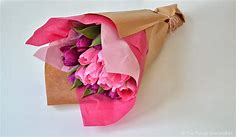The Art of Flower Wrapping Paper: Enhancing the Beauty of Bouquets


Flower wrapping paper is more than just a means to hold a bouquet together. It plays a crucial role in enhancing the aesthetic appeal, preserving freshness, and conveying sentiments. Whether you are a professional florist or a hobbyist, understanding the nuances of flower wrapping paper can elevate your floral arrangements to a new level. This blog post will delve into the types of flower wrapping paper, their benefits, creative wrapping techniques, and tips for choosing the right paper for different occasions.
The Importance of Flower Wrapping Paper
Enhancing Aesthetic Appeal
The primary function of flower wrapping paper is to enhance the visual appeal of the bouquet. The right wrapping paper can complement the colors and types of flowers, creating a harmonious and striking arrangement. It adds a finishing touch that can transform a simple bunch of flowers into a sophisticated gift.
Preserving Freshness
Flower wrapping paper helps in maintaining the freshness of the flowers by providing a protective layer against environmental elements. It shields the delicate petals from wind, sun, and temperature fluctuations, ensuring the bouquet remains vibrant for longer.
Conveying Sentiments
The choice of wrapping paper can convey different sentiments and messages. For example, elegant and luxurious paper might be used for a romantic occasion, while bright and cheerful paper could be perfect for birthdays or celebrations. The wrapping paper adds a layer of personalization to the floral gift.
Types of Flower Wrapping Paper
Kraft Paper
Kraft paper is a popular choice for flower wrapping due to its natural, rustic look. It is sturdy, versatile, and provides excellent protection for the flowers. Kraft paper can be left plain for a minimalist aesthetic or decorated with ribbons and tags for added charm.
Tissue Paper
Tissue paper is lightweight and comes in a variety of colors and patterns. It is often used to add a splash of color and texture to the bouquet. Tissue paper is usually paired with other types of wrapping paper to provide both protection and decorative appeal.
Cellophane
Cellophane is a transparent wrapping paper that adds a glossy finish to the bouquet. It is waterproof, making it ideal for preserving the freshness of the flowers. Cellophane can be used alone or layered with other papers to create a more dynamic look.
Fabric Wraps
Fabric wraps, such as burlap, linen, or cotton, are becoming increasingly popular for flower wrapping. They add a unique, tactile quality to the bouquet and can be reused, making them an eco-friendly option. Fabric wraps can be tied with ribbons or twine for a polished finish.
Patterned Paper
Patterned wrapping paper comes in a wide range of designs, from floral motifs to geometric patterns. It is an excellent choice for adding personality and flair to the bouquet. Patterned paper can be mixed and matched to create a custom look.
Creative Flower Wrapping Techniques
Cone Wrap
The cone wrap is a classic and elegant technique. To achieve this look, place the bouquet diagonally on a square piece of wrapping paper, fold one corner over the stems, and then roll the paper around the flowers, securing it with tape or ribbon. This method provides a snug fit and showcases the blooms beautifully.
Layered Wrap
For a more elaborate presentation, use multiple layers of wrapping paper. Start with a base layer of kraft or tissue paper, add a middle layer of cellophane for shine, and finish with a patterned or colored paper. Secure the layers with a ribbon or decorative string for a lush, textured look.
Envelope Wrap
The envelope wrap technique involves folding the wrapping paper around the bouquet as if wrapping a gift. Place the bouquet in the center of the paper, fold the bottom edge up over the stems, and then fold the sides inward, overlapping them at the front. Secure with tape or a ribbon. This technique creates a neat and professional appearance.
Rustic Wrap
For a rustic, natural look, use burlap or kraft paper. Wrap the paper around the bouquet loosely, allowing the edges to overlap naturally. Tie the wrap with twine or jute string and add a sprig of greenery or a small flower for decoration. This style is perfect for casual and country-themed occasions.
Tips for Choosing the Right Flower Wrapping Paper
Consider the Occasion
The occasion should guide your choice of wrapping paper. For weddings or anniversaries, opt for elegant and luxurious papers like satin or metallic finishes. For birthdays or casual celebrations, bright and cheerful patterns work best.
Match the Flowers
Choose wrapping paper that complements the colors and types of flowers in your bouquet. Neutral tones like white, beige, or kraft paper work well with most flowers, while bold colors and patterns can enhance simpler arrangements.
Think About the Recipient
Consider the recipient’s preferences and personality. If they appreciate eco-friendly products, opt for reusable fabric wraps or biodegradable paper. For someone who loves glamour, choose wrapping paper with metallic accents or glitter.
Quality Matters
Invest in high-quality wrapping paper to ensure durability and a polished look. Thicker papers provide better protection and hold their shape well, ensuring the bouquet stays intact and looks beautiful.
Conclusion
Flower wrapping paper is an essential element of floral arrangement, adding beauty, protection, and a personal touch to your bouquets. By understanding the different types of wrapping paper, mastering various wrapping techniques, and considering the occasion, flowers, and recipient, you can create stunning floral gifts that leave a lasting impression. Whether you are a professional florist or a DIY enthusiast, the art of flower wrapping offers endless possibilities for creativity and expression.

